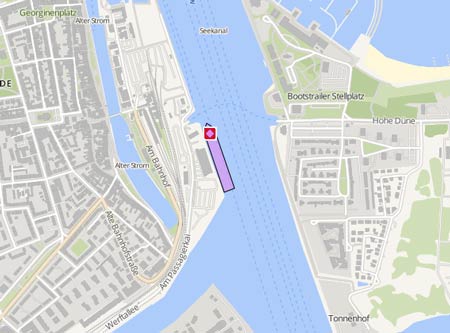JOANNE MARIE
Kurs/Position
Die letzten Häfen
Die letzten Wegpunkte
Die neuesten Nachrichten
NTSB report on partial sinking published
The National Transportation Safety Board (NTSB) has released an investigation report on April 8, 2024, on the flooding and partial sinking of the 'Joanne Marie' on June 25, 2023, in New Orleans, Louisiana, which was found partially submerged while moored at a shipyard on the Harvey Canal at6 a.m. There were no crewmembers or shipyard workers on board the vessel. An estimated 10 gallons of diesel fuel were released into the water. Damage to the vessel was $176,751. Analysis After the vessel was refloated, no water ingress into any vessel spaces was found, indicating the hull condition did not contribute to the flooding. Postcasualty testing found that, when water was pumped into the through-hull pipe for the propulsion shaft seals’ cofferdam overboard discharge, it entered the cofferdam, which was open to the engine room. The shaft seal cofferdam discharge system had two bilge pumps whose discharges combined into a single overboard line. The discharge lines had valves installed to prevent water ingress. After the casualty, investigators found that a wire nut had lodged in a spring-loaded check valve on the starboard-side bilge pump discharge line, obstructing the valve and forcing it to remain partially open (the swing-type check valve on the portside bilge pump worked properly). Investigators could not determine how the wire nut had entered the cofferdam. The wire nut may have been inadvertently dropped or fallen into the cofferdam when the deck plate covering the cofferdam was removed for regular maintenance. The Coast Guard and company representatives found that the wire nut was small enough to pass through the cofferdam bilge pump inlet strainer, so when the cofferdam bilge pump activated, the wire nut was pulled through the strainer and subsequently the pump impeller and discharge line before reaching the spring-loaded check valve. The spring-loaded design of the check valve held the wire nut in place, leaving the valve in a partially open position and susceptible to backflow. The National Transportation Safety Board determines that the probable cause of the flooding and partial sinking of the 'Joanne Marie' was the ingress of water into the engine room through a through-hull pipe located near the waterline due to an obstructed spring-loaded check valve on a cofferdam bilge pump discharge. Contributing to the sinking were inadequate procedures for securing unattended vessels. Full report: https://safety4sea.com/wp-content/uploads/2024/04/NTSB-Partial-skinking-of-towing-vessel-Joanne-Marie-2024_04.pdf
News schreiben

